#Whaleback Lighthouse
Explore tagged Tumblr posts
Text

Whaleback Light, Kittery. In 1886 waves from a powerful storm broke the windows, and water poured into the lighthouse. Keeper Leander White used a blanket to signal for help.
Today on Maine Calling (Maine Public Radio at 11am), a special on Maine's Lighthouses! And tonight (Sept 4th) at 8:00 on Maine Public Television, the premier episode of, Safe Harbors: Lighthouses of Maine. Yay!
#Whaleback Lighthouse#Whaleback Light#Maine#Kittery#lighthouse#Maine lighthouses#Maine lighthouse#York County#illustration#jada fitch#art#drawing#wave#storm#call for help#help#distress#distress signal#lighthouse keeper#Maine landmark#lighthouse in storm
135 notes
·
View notes
Text

Whaleback Lighthouse during sunrise, with the Wood Island Life Saving Station visible in the background. Located in Kittery Point, Maine, USA.
📸 by Barry Mullin @new_england_lighthouses
#Barry Mullin#@StormHour#@ThePhotoHour#Sunrise#Whaleback Lighthouse#Kittery Point#Maine#USA#@new_england_lighthouses#Nature#Travel#Lighthouses#Photography
18 notes
·
View notes
Text

Whaleback Lighthouse
Kittery Point, Maine
Drone flight from Ft. Constitution in New Castle, N.H.
145 notes
·
View notes
Text

where there is darkness: now complete
pairing: dean/cas tags: historical au, angst with a happy ending, slow burn, h/c
When Castiel Milton takes a job to be the new assistant keeper at Whaleback Lighthouse in Kittery, Maine, he expects to live out his new life in quiet isolation. What he gets instead is Dean Winchester: bitter, brash, and, like Castiel, harboring a dark secret. As the spark of attraction between them grows into a flame, the lighthouse walls start closing in—as do the ghosts of Dean and Castiel's checkered pasts.
read on ao3
last time tagging! thank you so much for following this story!! <3
@nelkey @fillybutt @beesandbasil @svs15 @munchablemusic @jimmycoded @kat-the-hobbit @uhoh-spn @angelinthefire @bloodydeanwinchester @umijustwantedtoreturnthis @green-eyes-and-classic-rock @halevetica @pixiedustandbluebutterflies @angelcasendgame @im-some-lionheart @connorlikesshows @galacticmermaid @agreyrose @plutoisaplanetfightme @rad-bitch-sad-bitch @myst-of-oblivion @cassierobinsons @deanwinchesterapologia @pinkmondaysworld @isaurariv @spittingpagan @naughtystiel @michaelwitha @afeelingsosweet @nsilvers-personal-treasury @doctorprofessorsong @shallowseeker @ladystardust @happilyfeatherafter @here-for-thee-gay-shit @justaskmetostay @empires-and-angels @little-pies @ferahal @dreamsoverflow @rikiricebackup @jensenackhles @justafictionlover @kidnapingallthepossums @tboydean @sophie-loudmouth @annmariethrush
#destiel#destiel fic#i can't believe this is over#no truly it doesn't feel real#wtidspn#where there is darkness
305 notes
·
View notes
Text

Crescent Moon rising over Whaleback Lighthouse in Kittery Maine. Comprised from ~50 photos taken over ~8 min period from 5:52AM to 6:00AM.
~50 frames 1 Sec, 1.3 Sec, 1.6 Sec and 2 Sec �� f / 6.3 • 600mm • ISO 1600 & 3200
Gal Steinberg Photography
#art#color photography#moon#crescent moon#kittery maine#vieformidable#design#architecture#interior design#photography#foodporn#fashion#interiordesign#lighthouse#kittery lighthouse#maine#photographer#landscape#nature
64 notes
·
View notes
Text
Whaleback Light, Kittery, ME

The Whaleback Lighthouse was originally established in 1831. It stands at 15 feet tall and used a fourth-order fresnel lens. The fog bell was installed in 1863. After damage to the tower, it was rebuilt in 1872. That tower is still standing today.
6 notes
·
View notes
Text

Whaleback Lighthouse
Kittery, Maine
Gal Steinberg
seasoflife
20 notes
·
View notes
Text

Good Morning from Whaleback Lighthouse - Kittery,Maine. John Burke Photography
19 notes
·
View notes
Text
The Gulf Of Maine Is Warming Fast. What Does That Mean For Lobsters—And Everything Else?
National Geographic photographer Brian Skerry has been diving in the Gulf of Maine for more than 40 years. After learning these waters were a harbinger of climate change, he set out to document the rapid shift and its ripple effects.
— Photographs By Brian Skerry | As Told To Anna Peele | May 14, 2024
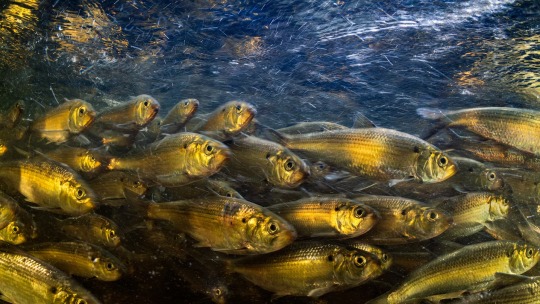
A large school of alewives migrates upstream through Mill Brook, an inland stream with waters that eventually flow into the Gulf of Maine. These fish live in the ocean but return to fresh water to spawn. Once depleted, the species rebounded after dam removals in the area, and now feed a variety of other fish, birds, and mammals.
The bounty of the Gulf of Maine. The sea within a sea, as it’s often called, is a body of water that extends 36,000 square miles along the eastern seaboard of North America, from Cape Cod, Massachusetts, to New Brunswick, and encompasses the coastlines of New Hampshire, Maine, and Nova Scotia. Indigenous Americans who have lived in this region for more than 12,000 years learned the gulf’s natural rhythms and sustainably harvested its rich waters. Europeans who began to settle in the area in the 15th century recorded tales of an endless abundance, with cod that measured up to five feet long. Before the American Revolution began, giant lobsters and thick schools of fish would have had a front-row seat to the Boston Tea Party.
I think of the Gulf of Maine as having been created from a perfect recipe that required a precise series of ingredients and steps. There is a robust watershed with many rivers flowing into the sea and a unique blend of currents that bring and mix nutrients, including upwelling from the continental shelf, the Gulf Stream, the Labrador, and counterclockwise coastal currents. Because of the Gulf of Maine’s geographic location in a temperate zone, a seasonal stratification that separates water into warmer and cooler layers also occurs here. The result has historically been the proliferation of life. But things have changed.
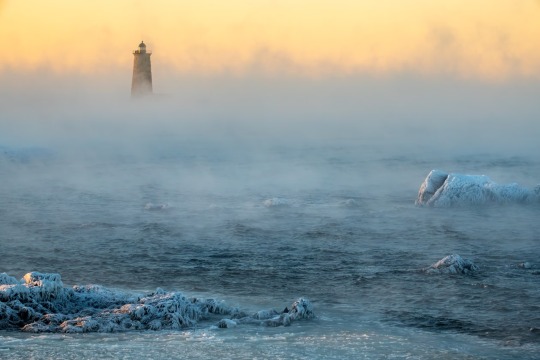
Sea smoke rises over the ocean near Whaleback lighthouse at the mouth of the Piscataqua River in Kittery, one entrance to the Gulf of Maine. This fog forms when very cold air moves over warmer water, mixing with a shallow layer of warmer air above the ocean’s surface. As the warmer air cools, the excess vapor condenses.
Over the centuries, the rise of sophisticated commercial fishing fleets has led to a steep decline in marine wildlife. Atlantic cod, its supply once believed to be inexhaustible, is now at one percent of colonial levels. So within just a couple hundred years, we have removed 99 percent of this species from the region. In the past four decades spent exploring these waters, I have witnessed how such declines have made the ecosystem weaker and more vulnerable in ways I never imagined.
I grew up in a working-class town in Massachusetts, about 40 miles from the ocean, but my parents would take me to the beach in summertime. As early as I can remember, I fell in love with the sea. My dream was to be an ocean explorer and photographer, sharing all that I saw and learned. In my 26 years of capturing images for National Geographic, I’ve been fortunate to work on all seven continents and in nearly every marine ecosystem from the Equator to the poles. I have always felt, however, that the ocean suffers from a bit of a curse in that its exterior hides what lies beneath—both the exquisite natural beauty and the ongoing devastation.
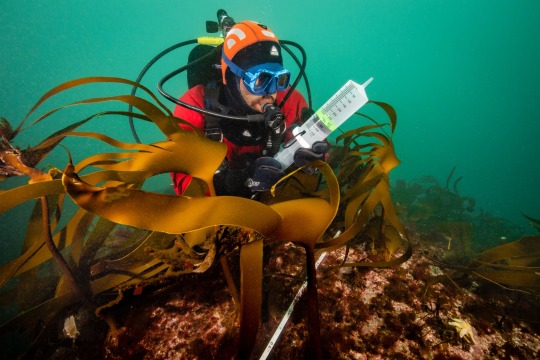
Marine ecologist Douglas Rasher collects water samples from a kelp forest near Winter Harbor. Along the southernmost coast of Maine, these essential marine habitats appeared healthy a few years ago but are now vanishing.
That’s why the most crucial part of my job doesn’t really happen in the water. Before each expedition, I first dive as deeply as possible into the world of researchers who dedicate their lives to understanding marine animals and their relationship to the environment. Only then can I bring the right visual context. Whether they’re images of orcas using different feeding strategies in order to share the rich complexity of whale culture or photos of a five-day-old harp seal pup falling through thin ice to show how deadly our warming planet has become for some species, my goal is to help people understand what’s happening in our world.
In Hot Water
Parts of the Northwest Atlantic, especially the Gulf of Maine and the Labrador Sea, have been heating up faster than 99 percent of the World’s Oceans.
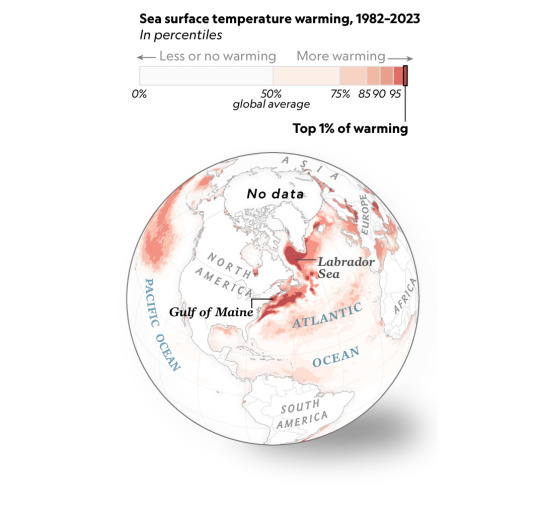
Why The Gulf Is Warming So Fast: The Gulf of Maine resembles a deep tub, its shallow banks inundated by cold Arctic waters. But melting fresh-water glaciers and other effects of climate change are altering long-established currents, according to the Gulf of Maine Research Institute, causing temperatures to warm three times as fast as other ocean waters.
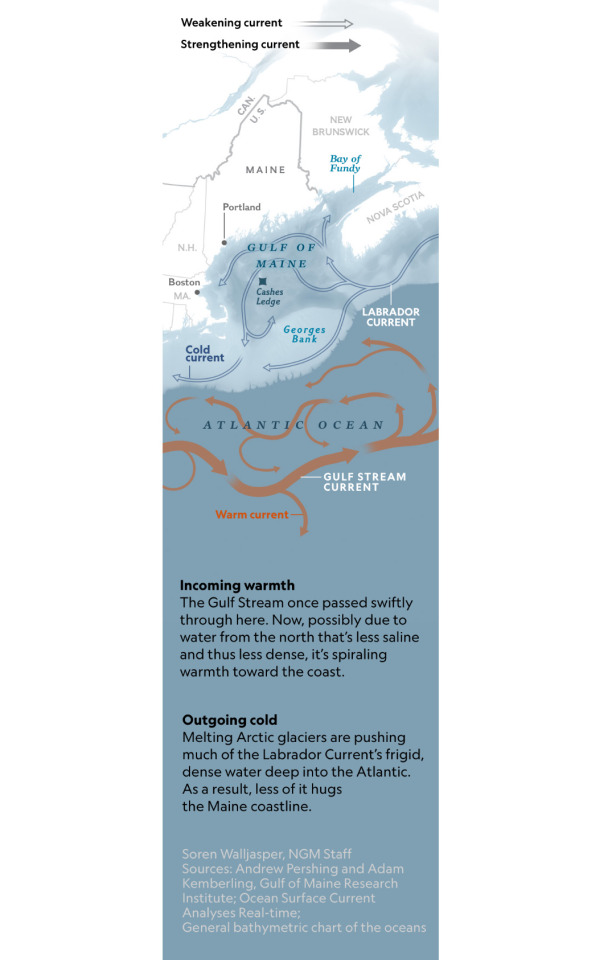
Years ago, I moved to the coast of Maine to more frequently explore these waters. In doing so, I saw signs of a looming threat. People in marine science and conservation communities had grown alarmed after reading a 2015 paper by Andrew Pershing (1), then chief scientific officer at the Gulf of Maine Research Institute. Within a few years, it became common knowledge among locals that the Gulf of Maine was warming faster than 99 percent of the world’s oceans.
— (1) Pershing’s report, “Slow Adaptation in the Face of Rapid Warming Leads to Collapse of the Gulf of Maine Cod Fishery,” sparked research that shows how these waters have continued warming at an alarming rate.
I now felt an urgency to share the wonder of my native waters—to focus on the beautiful wildlife that remains while highlighting the effects of climate change. To get it right, to make sure my images were representative of that change and its enormous impact on the region, I contacted many scientists and experts who have spent decades studying the gulf.
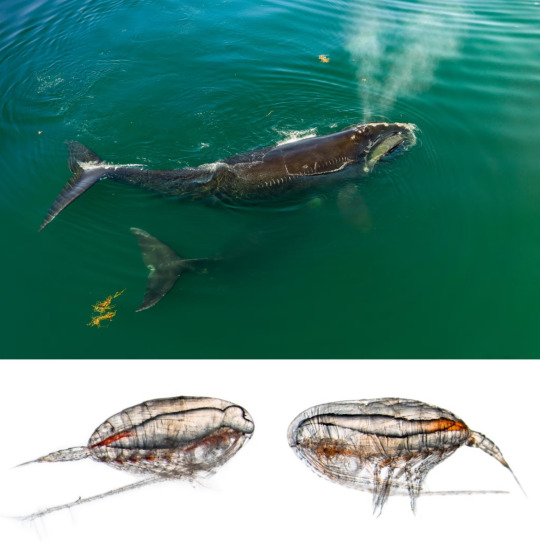
Top: Rare North Atlantic right whales glide through Cape Cod Bay in Massachusetts. These whales, some of the most endangered in the world, feed primarily on tiny creatures called copepods. As water temperatures rise, copepods have become leaner, imperiling the whales and larval lobsters that depend on them.
Bottom: These copepods, Calanus, are the main source of food for the endangered North Atlantic right whale and larval lobsters. When the copepods descend into deep waters to hibernate, they typically store 70% or more lipids (left). With rising water temperatures throughout the year, they don’t need as much fat to survive and in turn are skinnier (right). This means larval lobsters and right whales may not be getting enough nutrients year over year.
My original plan was to visit the most spectacular locations I had dived in decades past—places like Eastport, Maine, where the extreme tides of Passamaquoddy Bay exchange water and nutrients multiple times a day. I remembered Eastport as a cold-water kaleidoscope of fish species and invertebrates that could be seen easily just by making a dive from the beach. But when I got there, it was like a ghost town. The abundance of life that I had seen before was gone. Where exotic-looking creatures once carpeted the bottom, now there was only mud. Water temperatures were noticeably warmer.
The singular mix of elements that made the Gulf of Maine a fertile oasis is the reason it is now warming faster than almost anywhere else. These waters are also a harbinger for what the rest of the world might see. According to Charles Tilburg (2), an oceanographer and the director of marine and environmental programs at the University of New England, the gulf works “like a bathtub: If you turn down the cold water and turn up the hot water, the bathtub’s going to get warmer.” Tilburg has spent about 15 years tracking how the frigid Labrador Current is weakening, providing less cold water to the gulf, while the hotter Gulf Stream is shifting slightly north and adding warmer water to the region.
— (2) More than 60 rivers flow into the Gulf of Maine, adding water that is on average warmer than the ocean, Tilburg explains. Meanwhile, the region’s relatively shallow waters also absorb atmospheric heat.
But despite the collective stresses of overfishing and climate change, there are some species that have benefited, if only temporarily.
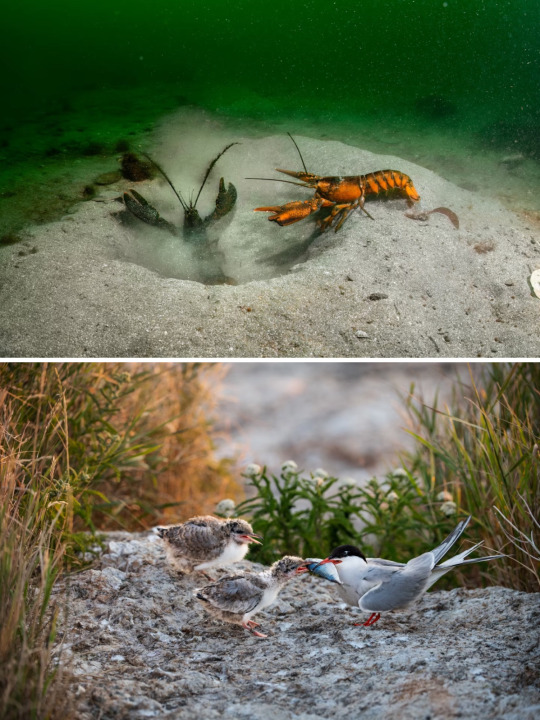
Top: Two lobsters fight over a burrow near the Isles of Shoals.The species has been booming, and typical rocky shelters—where lobster predators also lurk—are becoming overcrowded.
Bottom: A common tern tries to feed its chick a butterfish, but the offering is too wide to swallow. Butterfish now outnumber the slender silverfish that terns favor, such as herring and sand lance.
So far, temperatures in the Gulf of Maine have stayed suitable for lobster reproduction—the lobster-fishing industry appears to be flourishing. But scientists have identified some troubling changes. When temperatures rise to more than 73 degrees Fahrenheit near the coast, female lobsters stay farther offshore, where offspring they release might not intersect with currents that can carry them to the food sources and habitats that are more conducive to survival. These so-called larval lobsters eat zooplankton. Their preferred prey is Calanus, a two-to-three-millimeter copepod that is made up of mostly fat to sustain them through the winter. David Fields (3), a professor of oceanography at Bigelow Laboratory for Ocean Sciences, calls it “the French butter of copepods,” good for bulking up little lobsters.
— (3) Fields has found that copepods are 73 percent lipids, providing critical nutrition for the animals that eat them. These zooplankton are crucial to the survival of not just lobsters; they’re the primary food for endangered North Atlantic right whales.
As the water warms, Calanus copepods no longer need as much fat and grow smaller. That means the baby lobsters lose out on nutrition. Additionally, the warming water has shifted the Calanus’s migration period, which is putting it out of sync with the release of larval lobsters. So even though female lobsters are producing the same number of eggs as before, fewer are surviving into adulthood. In 2023, Maine saw the lowest lobster haul in 15 years, mimicking what’s been happening off the coasts of New York, Connecticut, and Rhode Island.
There’s more bad news for lobsters. The same carbon emissions behind climate change affect not only the ocean’s temperature but also its chemistry. The water is becoming more acidic. Fields says anything with a calcium exoskeleton or chitinous shell, from coral reefs to copepods, can get eroded by such acidification. It could potentially threaten a young lobster’s fragile exoskeleton in 10 or 20 years.
Other disturbing trends have surfaced. Win Watson (4), a marine biologist and emeritus professor at the University of New Hampshire, has studied the changing pH that may endanger lobsters’ ability to smell. That could make it harder for them to find food, detect predators, or sense each other’s pheromones during mating season, which has already gotten more difficult because female lobsters prefer colder temperatures, while males are fine in warmer water. Mates are literally drifting apart.
— (4) Watson has published dozens of scientific papers about lobster biology. Over the years, his research group used ultrasonic tracking, underwater video, and acoustic monitoring to study how lobsters move across the ocean floor and communicate with one another.
On this ocean planet, what happens underwater clearly has consequences on land. For example, the changes occurring with fish populations in the Gulf of Maine are having a direct impact on seabirds. Tern parents see silver fish reflecting sunlight in the ocean and bring them back to their chicks. When parents hunt their typical prey, such as hake or herring, the hatchlings can swallow these slender, silver fish easily. But as the water warms, terns can choose their prey from a larger range of silver fish such as the wider-bodied butterfish, which have shifted north from the mid-Atlantic.
Though some adult birds still find appropriate prey, to many, a silver fish may simply be a silver fish. Elizabeth Craig (5), director of seabird research at the Shoals Marine Laboratory, which is largely funded by the New Hampshire Fish and Game Department, has found that the chicks are unable to swallow the butterfish. They’re not getting enough food, and many remain smaller and either die before they leave the nest or are too weak to migrate.
— (5) Craig recently published a paper showing how butterfish migration, because of warming oceans, appears to be having an impact on tern chick survival: Nearly 80 percent of the butterfish delivered to chicks by their parents don’t get eaten.
It’s a poignant reinforcement of what we already know: Ocean ecosystems are in decline. I’m seeing dramatic ecological changes that should take millions of years, and yet they’re happening in my lifetime. But there are success stories. Plenty of evidence shows that when we permanently protect places in the ocean, remove obstacles, and give marine life a chance, nature finds a way: It is resilient, and it can heal. But nature needs a little help.

Among the marvels that still exist within the Gulf of Maine are gray seals. One approached photographer Brian Skerry with wide-eyed curiosity during a recent dive at the Isles of Shoals.
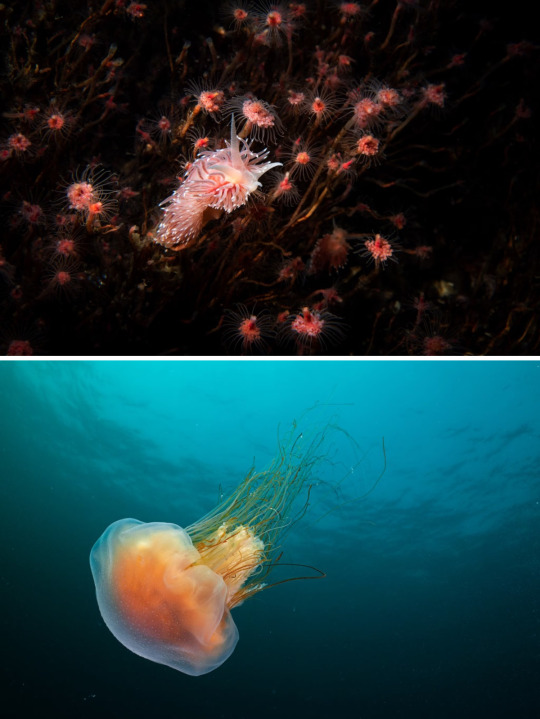
On other dives in the region, Skerry encountered wondrous creatures, including a species of filamentous nudibranch, or sea slug (Top) and this bioluminescent lion’s mane jellyfish (Bottom).
The Alewife Is One Story of Hope In The Gulf Of Maine. This species of fish is an important source of protein for many animals as it migrates from the freshwater ponds where it spawns to the ocean and then back again. In the ocean and in estuaries, where rivers flow into the sea, alewives are eaten by other fish and by birds such as eagles, ospreys, and cormorants. As they migrate into streams in the forest, they can become food for animals such as raccoons and foxes. Finally arriving at their spawning ponds, they must avoid predators like freshwater bass. Survivors of this gauntlet go back to the ocean, with their fry following a few months later.
Alewives had virtually disappeared from the gulf because dams kept them from migrating. The removal of dams in key rivers such as the Penobscot and Presumpscot, done largely in hopes of restoring Atlantic salmon populations, resulted in the revival of the alewife’s ancient migratory route; runs of fish in the millions now occur every spring. One beautiful experience I’ve had in recent years was photographing alewives at the base of a waterfall in Mill Brook Preserve, a tributary of the Presumpscot. The fish gather there to rest before going up the falls. Lying with my camera in only two feet of water, I was surrounded by thousands of alewives swirling around me, the way I imagine the river would have been long ago.
Perhaps the most special place I have explored in this region is Cashes Ledge, a unique underwater mountain range in the middle of the Gulf of Maine. Jon Witman (6), a marine ecologist at Brown University, calls it a time machine to when the gulf was packed with marine life.
— (6) Witman is the lead scientist on the effort to achieve permanent conservation protection for Cashes Ledge, in partnership with Conservation Law Foundation.
As Witman has documented, Cashes has one of every kind of offshore or subtidal marine habitat that exists off the coast of New England, with species rarely seen elsewhere. Because of the ledge’s submerged rocky ridges, waves and currents push large amounts of plankton to the creatures that eat it; Witman says it’s like a food elevator.
In order for climate stability to even be possible, researchers say, we need to protect a minimum of 30 percent of key habitats in the ocean. Today only about 8 percent are formally protected. For Witman, who has been studying Cashes since the 1970s, designating the area as a marine sanctuary feels more urgent than ever. By protecting it, we would help ensure healthy fishery stocks in the future. The fish biomass in Cashes is 300 times that on the coast; animals that live there obviously don’t just stay in one place, so they propagate and spill over.
Cashes also contains the largest kelp forest off the coast of the eastern United States. That’s important because kelp serves as both the base of the food chain and a distinct ecosystem. As a diver, I’ve marveled at the vastness of this amber- and crimson-colored forest swaying so far beneath the surface. For his part, Witman compares the underwater journey to Cashes to a drive through the plains of Iowa for hundreds of miles and coming across a huge mountain with a forest. And like the woods on land, kelp forests capture carbon. The ocean is the greatest carbon sink on our planet, and its phytoplankton give us every other breath that we draw.

Top Left: A cunner hovers amid several large kelp fronds at Cashes Ledge, a marine area that researchers have identified as a vital sanctuary and hedge against climate change. Cashes’s kelp forest, which supports marine life while absorbing carbon from the ocean, is the largest off the coast of the eastern United States.
Top Right: Seafood harvesters with Bangs Islands Mussels have been raising blue mussels in Maine’s Casco Bay for more than a decade. The mollusks are grown on vertical lines that are attached to a raft and can be winched up for cleaning and sorting. Only those of a certain—larger—size are kept for sale, while the rest are returned to the water.
Bottom: Seafood harvesters with Bangs Islands Mussels have been raising blue mussels in Maine’s Casco Bay for more than a decade. The mollusks are grown on vertical lines that are attached to a raft and can be winched up for cleaning and sorting. Only those of a certain—larger—size are kept for sale, while the rest are returned to the water.
Exactly how big a role kelp plays in that process is being studied by scientists like Douglas Rasher (7) of Bigelow Laboratory for Ocean Sciences. He has spent nearly 10 years studying coastal kelp forests from the southern tip of Maine to its northern borders with Canada and documented their steady decline.
— (7) Rasher has found that warming seawater temperatures result in an invasive red “turf” that replaces habitats as kelp dwindles. This kind of underwater deforestation destroys healthy ecosystems.
Rasher’s research also shows just how fast things continue to change. He’s seen some study sites shift from a forested to deforested state in the span of a five-year research grant.
One Of The Ways Fishers have sought to mitigate potential economic damage from native species decline is by transitioning into new and sustainable ventures. Colleen Francke grew up on Cape Cod inspired by women in the fishing business. After a back injury ended her 10-year lobstering career, she launched Summit Point Seafood to grow kelp, which has a lower cost barrier than mussels or oysters. Francke submerges long lines seeded with kelp in the fall, then in spring sells the harvest to companies that make products like veggie burgers or that use the superfood to provide nutrients and a salt alternative to traditionally kelp-free fare like bread.
Another operation, Bangs Island Mussels, a family business in Casco Bay off the coast of Portland, farms kelp in conjunction with growing mussels. The company uses a method known as integrated multitrophic aquaculture, which allows these two species to grow in harmony with each other. It has a series of large rafts offshore equipped with vertical lines seeded with mussel spat—the scientific term for tiny juveniles—that will mature and be harvested for sale to restaurant wholesalers and distributors. Going out on the water with the Bangs Island harvesters was like watching craftspeople create something beautiful with their hands. The operations produce a renewable resource that may actually be beneficial to the environment.
Co-owner and CEO Matt Moretti is concerned that it will become harder for mussels to survive long enough to grow their shells in the wild because of ocean acidification. Bangs Island Mussels is developing nursery technology at its indoor facility for baby mussels, so that they have the best chance of surviving their vulnerable pre-shell period. Mussels can grow in captivity until their exteriors are thick enough to handle a more acidic ocean.
Meanwhile, some fishers are diversifying by looking to create new markets for species that have not traditionally been commercially harvested. A couple of my neighbors, Sam Sewall and Mike Masi, have teamed up to build a green crab business called Shell+Claw. Green crabs, an invasive species, live mostly in estuaries.
Green crabs were introduced into the Gulf of Maine in the 1800s, brought in by the ballast water of ships. Until recently, their population was kept in check because of the cold winters, but with climate change yielding milder temperatures, their numbers have exploded. They dig into the mud and cut off the roots of eelgrass, which captures nitrogen and carbon and acts as a nursery for estuarine species, and smooth cordgrass, which critically stabilizes riverbanks and fights erosion.
Green crabs also eat clams, historically the second or third most valuable fishery in Maine. Shell+Claw’s business idea is to mitigate the damage caused by green crabs while creating another source of income for its partners who are willing to experiment. Working with researchers, Masi has started to figure out when the crabs molt, thus becoming soft-shell crabs that are edible. The goal is to mimic what’s being done in Venice, Italy, where a similar type of crab is sold as a delicacy. Masi, a former marine biology teacher at the local high school, says harvesting these crabs is probably always going to be a supplemental business for fishers. But clam prices are at their lowest when green crabs are molting in late spring, so the venture can dovetail economically and give clams a chance to recover their population.
When the shedding begins, Masi and Sewall—a 27-year-old former student of Masi’s and fourth-generation lobsterman—immediately take the soft-shell green crabs to high-end seafood places in Boston and Portsmouth, New Hampshire, that are paying a premium to fry them up as sliders or tempura.
So perhaps there is hope for the Gulf of Maine. As I continue to explore these waters, I am troubled by much that I see; the warning signs mirror obvious trends in scientific data. I often think about what the Native tribes—the Wampanoag, Abenaki, Passamaquoddy, and Mi’kmaq—must have seen long ago, and I dream about traveling back in time, hundreds of years, to dive in those waters teeming with life.
Although we have lost so much over the centuries and are facing serious threats today, I still find magic in the Gulf of Maine. My hope is that, armed with the knowledge of the past and the science of today, we can save what remains. And allow it to rebound.
— An Explorer since 2014, Brian Skerry first dived in the Gulf of Maine more than 40 years ago. In this issue, he shares how the area has become a harbinger of climate change. Skerry has contributed more than 30 features to the magazine. His last story was “Secrets of the Whales” in 2021, which accompanied the Emmy Award–winning documentary series that he produced. It’s available to stream on Disney+.
#Environment#Oceans 🌊 | Climate Change | American 🇺🇸 Lobster 🦞🦞🦞 | Whales 🐳 🐋#Ocean Life | Underwater Photography| Wildlife Photography#Water 💧 💦 Pollution#National Geographic
0 notes
Text

Whaleback lighthouse in Kittery Maine at sunrise this morning. Shot from Newcastle NH. 11/3/23.
Photo by John Burke.
Source: Facebook
Lighthouses of the World
1 note
·
View note
Text

title: where there is darkness pairing: dean/cas tags: historical au, angst with a happy ending, slow burn, h/c
Maine, 1951: When Castiel Milton takes a job to be the new assistant keeper at Whaleback Lighthouse, he expects to live out his new life in quiet isolation away from civilization. What he gets instead is Dean Winchester: bitter, brash, and, like Castiel, harboring a dark secret. As the spark of attraction between them grows into a flame, the lighthouse walls start closing in—as do the ghosts of Dean and Castiel's checkered pasts.
Prologue and Chapter 1 now on ao3
**a note on the taglist: there's a whopping 101 of you, and i love each of you DEARLY, but there's no way I can tag that many people each week, so please either subscribe to my ao3 for updates or follow the tag #wtidspn for updates!**
taglist! (sidenote there's NINETY OF YOU HELLO so I'll be only doing this taglist on this post, so make sure to subscribe to my ao3/watch my tumblr for updates!!)
@munchablemusic @markofcastiel @jimmycoded @kat-the-hobbit @uhoh-spn @angelinthefire @bloodydeanwinchester @umijustwantedtoreturnthis @green-eyes-and-classic-rock @halevetica @pixiedustandbluebutterflies @angelcasendgame @im-some-lionheart @connorlikesshows @galacticmermaid @agreyrose @plutoisaplanetfightmebro @myst-of-oblivion @cassierobinsons @deanwinchesterapologia @rad-bitch-sad-bitch @isaurariv @pinkmondaysworld @spittingpagan @naughtystiel @michaelwitha @supernatastic101 @youarethedancingdean @milfdeanwinchester @afeelingsosweet @nsilvers-personal-treasury @doctorprofessorsong @shallowseeker @lesbians4scully @ladysstardust @happilyfeatherafter @here-for-thee-gay-shit @justaskmetostay @empires-and-angels @little-pies @ferahal @dreamsoverflow @rikiricebackup @jensenackhles @justafictionlover @kidnapingallthepossums @tboydean @saulvede @justtheghostofnothing @ialwayscomewhenyoucall
#destiel#destiel fic#where there is darkness fic#if you signal boost this you get a cookie#wtidspn#that's the only tag that wasn't taken with other random things lol#SO WE'RE ROLLING WITH IT
298 notes
·
View notes
Text
where there is darkness
where there is darkness https://ift.tt/Z1NkwP4 by quiettewandering Maine, 1951: When Castiel Milton takes a job to be the new assistant keeper at Whaleback Lighthouse, he expects to live out his new life in quiet isolation away from civilization. What he gets instead is Dean Winchester: bitter, brash, and, like Castiel, harboring a dark secret. As the spark of attraction between them grows into a flame, the lighthouse walls start closing in—as do the ghosts of Dean and Castiel's checkered pasts. Words: 6895, Chapters: 2/25, Language: English Fandoms: Supernatural (TV 2005) Rating: Explicit Warnings: No Archive Warnings Apply Categories: M/M Characters: Dean Winchester, Castiel (Supernatural), Sam Winchester, Bobby Singer (Supernatural) Relationships: Castiel/Dean Winchester Additional Tags: Angst with a Happy Ending, Historical Fiction with some inaccuracies, Mutual Pining, Slow Burn, Hurt/Comfort via AO3 works tagged 'Castiel/Dean Winchester' https://ift.tt/Xqycl4F August 31, 2023 at 11:54PM
#IFTTT#AO3 works tagged 'Castiel/Dean Winchester'#Destiel#ao3feed#ao3feed Destiel#Destiel fanfic#Dean Winchester/Castiel#Castiel/Dean Winchester#Dean x Castiel#Castiel x Dean
0 notes
Text

Shots from #Maine on our #Instagram feed, tag us @RoadTrip_NewEngland (bit.ly/2qyTftg) with your best #MainePhotography each week to be featured
#roadtripnewengland #roadtrip_newengland
#whaleback#whaleback lighthouse#lighthouse#lighthouses#lighthouse love#maine#ocean#ocean photography
0 notes
Photo









whaleback lighthouse drawing now available on my redbubble store!
#lizzie.draws.art#whaleback light#lighthouse#art#redbubble#prints available#artists on tumblr#disabled artist#ink drawing#digital art#my art#sketch#thanks to anon for suggesting i get redbubble <3
11 notes
·
View notes
Video
instagram
Happy New Year! A @canonusa 1000mm sunrise behind Whaleback Light from New Castle, NH - what a beautiful morning! #sunrise #newyear #welcome2020 #2020 #beginnings #canon #teamcanon #thebigguns #500mmf4 #whaleback #light #lighthouse #newengland #newhampshire @thedailyportsmouth @yankeemagazine #canonbringit - disclaimer: video is from a few days ago... (at Whaleback Light) https://www.instagram.com/p/B6x_8pjhdMO/?igshid=hvb1i3t4r0ds
#sunrise#newyear#welcome2020#2020#beginnings#canon#teamcanon#thebigguns#500mmf4#whaleback#light#lighthouse#newengland#newhampshire#canonbringit
1 note
·
View note
Photo

Determination by Jeff Folger https://buff.ly/2IgF3wa #Whaleback #Lighthouse from New Castle New Hampshire #NEPGuild #igMaine #USPixels⠀⠀ #landscapephotography #landscapelover #landscape_captures #landscapes #landscape_photography #pixel_ig #landscape_hunter #landscape_lovers #landscapecaptures #landscapestyles_gf #landscape_specialist #landscapeporn #getlost #landscapephotomag #ig_landscape #trapping_tones #ig_masterpiece #ig_podium #splendid_earth #gramslayers #optoutside #discoverearth #exploretheglobe #nakedplanet #places_wow
#landscape_captures#landscape_photography#landscapes#lighthouse#ig_podium#pixel_ig#landscapephotomag#landscapephotography#landscapecaptures#landscape_lovers#getlost#landscape_specialist#splendid_earth#whaleback#uspixels#ig_landscape#ig_masterpiece#landscapestyles_gf#igmaine#nakedplanet#optoutside#nepguild#discoverearth#places_wow#trapping_tones#landscapeporn#gramslayers#exploretheglobe#landscape_hunter#landscapelover
11 notes
·
View notes